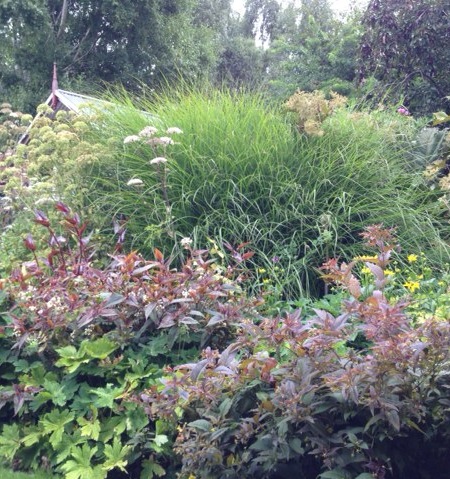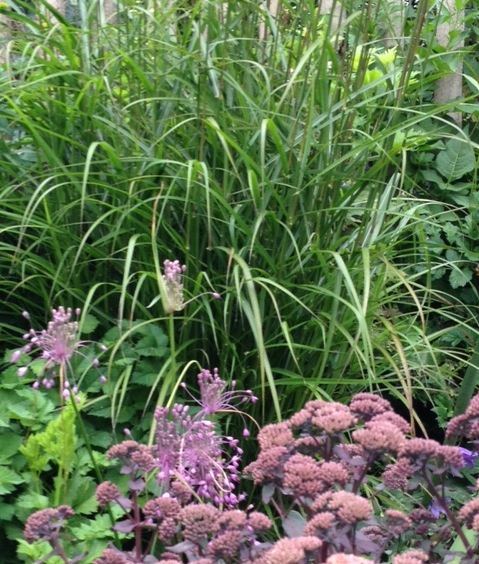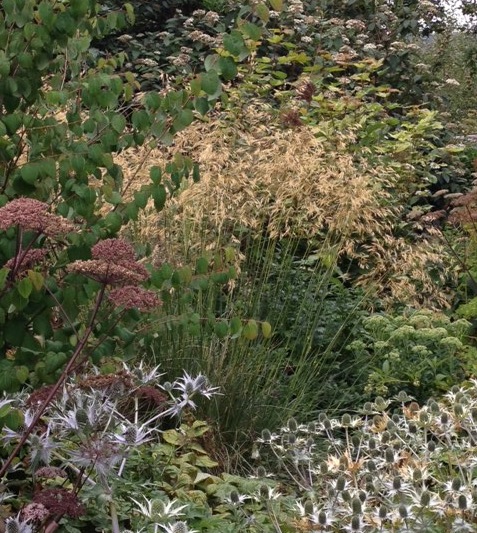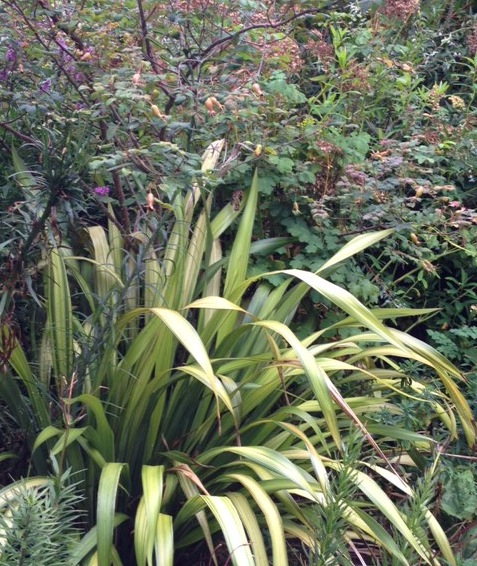It’s no secret that I have a passion for grasses – anyone who has visited my Wychwood garden in northern Tasmania knows it only too well. I discovered them not long after I ‘got into gardening’ and haven’t looked back since.

Miscanthus transmorrisonensis in a mixed border
I realise that some people are wary of them – and justifiably so in some cases – and also that some people simply don’t like them, referring to their appearance as ‘saggy’. This is a country term for the native grasses that dominate the natural Tasmanian landscape, and it is used in a derogatory way to mean that they look like weeds.

Miscanthus ‘Sarahbande’ in mixed border
I couldn’t disagree more. We have used grasses extensively here at Wychwood not just because we like their natural look, but because we believe that contrast is one of the most important elements in a garden. Imagine if you will a bed dotted with only one variety of plant. It may be striking, yes, but you don’t need to linger long to get the whole picture. It’s right there, no matter where you move your line of vision and after awhile you feel a need to move on. Whilst this works well in some settings (for instance where no-one wants to linger, like in supermarket car parks) a garden would be pretty dull if there wasn’t a little variety in the planting.

Smaller Miscanthus cultivar in mixed border
This is where different foliage form comes in, and grasses are among the best. Their naturalistic style, their vertical or fountain-like habit, and their ease of care make them indispensable in any garden.
Late season grasses are among the best. These are the grasses that generally (but not always) become dormant in winter and shoot back again in spring. Their growth coincides with the warming soil, and by late summer they are at their peak. Miscanthus sinensis cultivars are perhaps the best known, and justifiably so. Their fountain-like habit and beautiful plumes are stunning and these days there are cultivars of almost every size so we can all fit at least one into even the smallest garden. One of my favourites, however, is a relatively newly available species called Miscanthus transmorrisonensis. As you can see from my photo above, it is incredibly beautiful and we look forward to it every year.

Stipa arundinacae in mixed border
Stipa isn’t theoretically ‘late season’ because mostly they are evergreen, but as they flower in late summer I tend to classify them as such. One of the ones we have planted most widely is Stipa arundinacae – I think renamed Anemanthele lessoniana for some bizarre reason. It‘s coppery tints when grown in full sun are very appealing, and once I read that its flowers are like ‘freshly washed hair’.

Massed Stipa arundinacae (now Anemanthele)
Stretching the truth somewhat maybe, but they are very pretty nonetheless. As an accommodating, easy, yet lovely grass, it is hard to beat. It’s much larger cousin – Stipa gigantea – is more striking however, although only in bloom. Its foliage is sometimes a little ratty and needs cutting back, but its golden flowers and subsequent seedheads are delightful and make a beautiful cut flower. I think I’ve said before that if it can be planted to be silhouetted by the late evening sun, it’s nothing short of stunning.
 There is a school of thought that grasses shouldn’t be mixed with roses, but I would beg to differ. Again, it is all about contrast. What could be lovelier than a gently swaying soft grass behind a blousy bourbon rose in full bloom? In all honesty, although I am preaching to you about making sure you utilise contrast in your plantings, I am going to now contradict myself by saying that there shouldn’t be any rules about what you plant. If the combination of grasses and roses pleases you, go for it. It’s your garden.
There is a school of thought that grasses shouldn’t be mixed with roses, but I would beg to differ. Again, it is all about contrast. What could be lovelier than a gently swaying soft grass behind a blousy bourbon rose in full bloom? In all honesty, although I am preaching to you about making sure you utilise contrast in your plantings, I am going to now contradict myself by saying that there shouldn’t be any rules about what you plant. If the combination of grasses and roses pleases you, go for it. It’s your garden.

Phormium ‘Gold Wave’
For those people who still can’t bring themselves to plant a grass (and why not, I ask?), there’s still contrast to be had by way of any strappy, vertical foliage. Think iris, phormium (judiciously, please, the world is being over-run with phormiums, cordylines and white gravel), or kniphofia. Only a botanist could explain the scientific difference between these groups of plants, the overall effect in the garden is very similar. Any of these can give the same effect as a grass – breaking up blocks of foliage with their natural style and grace. Any fears of grasses ‘taking over’ the garden can be easily addressed by careful selection (avoiding any that are recognised weeds and instead choosing those bred for their good behaviour), and before long I feel sure you will recognise their charms and value their contribution to your garden.
